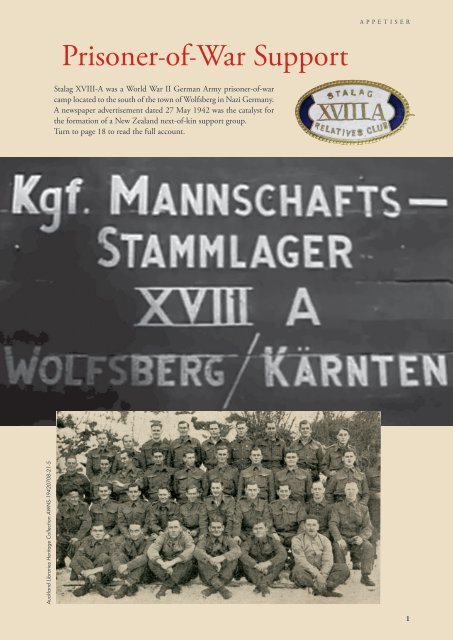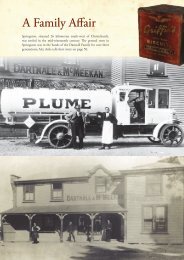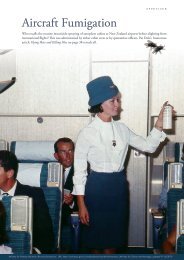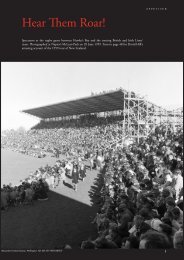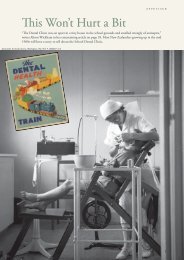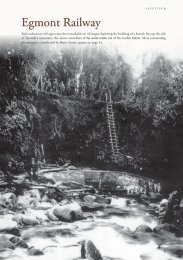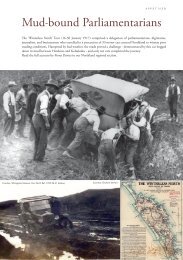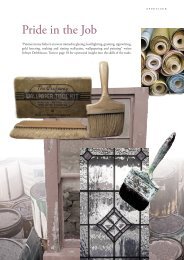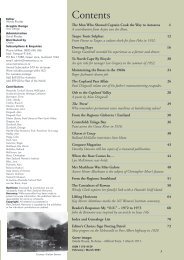New Zealand Memories Issue 160
Create successful ePaper yourself
Turn your PDF publications into a flip-book with our unique Google optimized e-Paper software.
APPETISER<br />
Prisoner-of-War Support<br />
Stalag XVIII-A was a World War II German Army prisoner-of-war<br />
camp located to the south of the town of Wolfsberg in Nazi Germany.<br />
A newspaper advertisement dated 27 May 1942 was the catalyst for<br />
the formation of a <strong>New</strong> <strong>Zealand</strong> next-of-kin support group.<br />
Turn to page 18 to read the full account.<br />
Auckland Libraries Heritage Collection AWNS-19420708-21-5<br />
1
EDITORIAL<br />
Dear Readers,<br />
Unlike our counterparts in the Northern Hemisphere, <strong>New</strong> <strong>Zealand</strong>ers cram<br />
Christmas, <strong>New</strong> Year celebrations and summer holidays into one big event<br />
to make the most of our climate. I hope you managed to balance the three<br />
successfully. If you are a grandparent, you will no doubt be ready to relax and<br />
what better way than to immerse yourself in our <strong>160</strong>th issue featuring the return<br />
of familiar authors with a selection of splendid new offerings.<br />
The leading article from first-time contributor Marie Chaillet-Bell illustrates<br />
changing times and gives a realistic glimpse of a family settling in Auckland in<br />
1914 and struggling to make ends meet. Times were hard but fun was still to be<br />
found.<br />
Then there are the stories with which we identify; David Grantham reminds us of<br />
the traditional Sunday roast, Gordon Tait takes us on a twentieth century holiday<br />
and Jeanette Grant will have readers humming a familiar radio jingle.<br />
Christopher Moor has a knack of procuring unique stories for the magazine and his true account of ‘The Bank<br />
House’ is no exception. “Only in <strong>New</strong> <strong>Zealand</strong>” I thought to myself as the tale unfolded.<br />
While searching on-line for photographs to illustrate Sue Courtney’s article, describing the formation of a<br />
prisoner-of-war support group by her grandmother in 1941, I came across a small museum in Northern Ireland<br />
with a Red Cross parcel amongst their collection. I contacted Inver Museum and they sent me the photograph,<br />
same day, along with permission to publish. We live in an instant society.<br />
The Rangitira Stowaway photograph on page 67 is from Lyttelton Museum’s fine collection - but it’s a<br />
collection without a home. If you are looking for a 2023 calendar, please support their rebuild.<br />
Warm wishes for a happy and healthy <strong>New</strong> Year.<br />
Wendy Rhodes,<br />
Editor<br />
Receive the next issue of<br />
<strong>New</strong> <strong>Zealand</strong> <strong>Memories</strong><br />
direct to your letterbox.<br />
A G i f t o f D i s t i n c t i o n<br />
Surprise a friend or relative with a gift. We will gift<br />
wrap the issue, include a gift card with your personal<br />
message and post it direct.<br />
Freephone: 0800 696 366 or<br />
Freepost: 91641<br />
PO Box 17288<br />
Green Lane, Auckland 1546<br />
Email: admin@memories.co.nz<br />
Visit our website w w w.memories.co.nz for back issues and gift ideas.<br />
Order online securely today and pay via internet banking or credit card or give us<br />
a call on our Freephone number<br />
2
Editor<br />
Wendy Rhodes<br />
Graphic Design<br />
Icon Design<br />
Administration<br />
David Rhodes<br />
Distributed by<br />
Are Direct<br />
Subscriptions & Enquiries<br />
Phone tollfree: 0800 696 366<br />
Mail: Freepost 91641,<br />
PO Box 17288, Greenlane, Auckland 1546<br />
email: admin@memories.co.nz<br />
www.memories.co.nz<br />
Contributors<br />
Albertland & Districts Museum<br />
Alexander Turnbull Library, Wellington, NZ.<br />
Auckland Heritage Collection<br />
Binet, Reverend Vincent<br />
Birchall, Barry<br />
Chambers, Betty<br />
Courtney, Sue<br />
Dalmatian Archive and Museum<br />
Duckett, Alan<br />
Grant, Jeanette<br />
Grantham, David<br />
Hill, David<br />
History House, Greymouth<br />
Kei Muri Mapara, Methodist Church<br />
of <strong>New</strong> <strong>Zealand</strong> Archives<br />
Mihaljevich, George<br />
Mitchell, Huia<br />
Moor, Christopher<br />
<strong>New</strong>sham, John<br />
Petchell, Phyl<br />
Smith, Jo<br />
Stewart, Graham<br />
Studd, Frances Jill<br />
Tait, Gordon<br />
Te Uaka The Lyttelton Museum<br />
Tiller, Eileen<br />
Walsh, Graeme<br />
Opinions: Expressed by contributors are not<br />
necessarily those of <strong>New</strong> <strong>Zealand</strong> <strong>Memories</strong>.<br />
Accuracy: While every effort has been made to<br />
present accurate information, the publishers take no<br />
responsibility for errors or omissions.<br />
Copyright: All material as presented in<br />
<strong>New</strong> <strong>Zealand</strong> <strong>Memories</strong> is copyright to the publishers<br />
or the individual contributors as credited.<br />
ISSN 1173-4159<br />
February/March 2023<br />
Contents<br />
Our Ancestors Came From France 4<br />
Marie Chaillet-Bell relates the joys and the hardships.<br />
The Bank House 12<br />
A vault in the hills of Naenae; a story from Christopher Moor.<br />
Sunday Dinners 14<br />
David Grantham’s account of a replicated roast meal in Christchurch.<br />
Stalag XVIII.A Relatives Club 18<br />
A WWII prisoner-of-war support group. Written by Sue Courtney.<br />
From the Regions: West Coast 24<br />
Lost in Words 34<br />
A street sign catches David Hill’s eye.<br />
Centrefold: A Life of Toil 36<br />
Clydesdale horses on Wellington’s Cambridge Terrace.<br />
Holidays at Te Moana Reserve 38<br />
Gordon Tait has fond memories of vacations north of Timaru.<br />
The Great <strong>New</strong> <strong>Zealand</strong> Exhibitions 40<br />
Barry Birchall records the history of these outstanding events.<br />
A Kiwi Girl’s Scrapbook 46<br />
An illustrative glimpse of life in the 1920s by Francis Jill Studd.<br />
The Copper 48<br />
Not just for doing the laundry!<br />
Tooth Tales 49<br />
Jeanette Grant returns with another amusing story.<br />
A Northland Pilgrimage, 1932 50<br />
Jo Smith recounts a motoring journey by four Methodist ministers.<br />
Rangitira Stowaway in Lyttelton 53<br />
A delightful contribution from Lyttelton Museum.<br />
Election Night in Blenheim 54<br />
“What a night that was”, writes Betty Chambers.<br />
From the Regions: Auckland 56<br />
Mailbox 67<br />
<strong>New</strong> <strong>Zealand</strong> <strong>Memories</strong> Back <strong>Issue</strong>s in Stock 68<br />
Index and Genealogy List 70<br />
Editor’s Choice: Canterbury Stopover 72<br />
Coach team outside the Glacier Hotel, Bealey in 1882.<br />
Cover image:<br />
Much activity on Queen Street Wharf, 8 February 1904.<br />
Auckland Heritage Collection Ref: 1-W1089<br />
3
STORY<br />
Our Ancestors Came<br />
From France<br />
Marie Chaillet-Bell<br />
My great-grandfather, Charles Nemours Chaillet, was<br />
born between 1820 and 1830 in the ancient town<br />
of Nemours in Brittany some hundred kilometres<br />
southeast of Paris. Charles became a fencing master<br />
and wed; this first marriage failed. His second marriage was to a<br />
young woman by the name of Louise Foulan and, for a new life, they<br />
emigrated to South Africa where Charles found work as a park manager<br />
at Greenpark, a large sugar plantation just outside Durban in Natal.<br />
The couple was blessed with two children, Gaston (born in 1881) and<br />
Lydie a little later. As an adult, Gaston eventually took over from his<br />
father as manager of the plantation.<br />
During sister Lydie’s wedding, Gaston met a young woman named<br />
Noelie Martial, the groom’s sister. Noelie came from Mauritius, a<br />
French Republic island well out in the Indian Ocean. Her father, a<br />
Frenchman, was a trader / businessman and her mother had died so two<br />
maiden aunts brought up Noelie. A wealthy family, Noelie’s upbringing<br />
included all social niceties of life. Gaston wooed her, she accepted and<br />
they married. They should have been happy but life in Durban was very<br />
different. Because Noelie was of mixed blood (Indian I believe) she was<br />
not accepted by the owners and forced to work in the kitchens. A mixed Gaston, Noelie and Louis Chaillet.<br />
marriage was frowned upon.<br />
When my father, Louis, was born in 1907 he had light brown skin and, consequently, was not accepted at the<br />
plantation school. His sister Madeleine, four years younger and white skinned, had fewer problems. By 1913 the<br />
family had had enough and they decided to leave. Where to? How they chose <strong>New</strong> <strong>Zealand</strong> I will never know<br />
but with the two children and all belongings they headed into the unknown. They arrived in Auckland in 1914<br />
not long after the start of the First World War.<br />
The following is an excerpt written by my father describing those early days. It was written before he died in<br />
1983.<br />
‘In late 1915 we were living in Ponsonby when farming beckoned my father as a promising career; apart from<br />
managing a large sugar plantation in South Africa, he had little knowledge of working the land. He bought<br />
a fifty-acre block of land, the boundary of which ran for a short distance alongside Murphys Road in South<br />
Auckland, then circled back to meet Redoubt Road in the vicinity of Mill Road. There was no house on the<br />
property which had only ten acres in grass the rest covered in blackberry, gorse, fern, tea tree and some native<br />
bush bordering a stream.<br />
I remember travelling by train to Papatoetoe where we were met by the farmer from whom we were renting a<br />
cottage, until our own house was built. When we arrived at the cottage, situated almost directly opposite Mill<br />
Road, we were surprised to find no signs of the horse-drawn van bringing our furniture and food supplies which<br />
had left Auckland earlier that day.<br />
Late in the afternoon my father decided to investigate and found the van stuck in the mud at the corner of<br />
Great South Road and Redoubt Road. The van could not be moved until the next day when more horses would<br />
be available. A kindly neighbour gave us milk and bread for our evening meal and breakfast when she discovered<br />
our plight. That night we slept on the floor, with newspapers as bed covers.<br />
Once settled in, my father proceeded to build our house and an outdoor privy similar to those in South Africa,<br />
where a deep hole had its sides boarded in with timber to prevent a cave-in of the sandy soil which provided<br />
natural drainage. The clay sub soil in Redoubt Road required no timbering and thereby hangs a tale.<br />
4
STORY<br />
“… our penny-a-week each pocket money was spent in buying<br />
a comic, a bag of conversation lollies or a lucky packet…”<br />
The next task was to bring the property into<br />
cultivation - a backbreaking task achieved with the aid<br />
of a post-hole borer, a slasher and grubber, a couple<br />
of horses, a plough, and a set of discs and harrows.<br />
My mother, who had enjoyed a privileged life, was<br />
now indulged in slashing gorse and blackberry and<br />
grubbing out roots in the soil. This life diminished<br />
her spirit and she became withdrawn with only the<br />
occasional brief glimpse of her happy self.<br />
My parents toiled all day. At night they burned off<br />
the huge piles of cut scrub. Concerned about this<br />
nightly burn-off, one of the neighbours contacted<br />
the police. As our family were from a country which<br />
had fought against Britain during the Boer War, this<br />
neighbour felt we were more aligned to Germany, and<br />
with Redoubt Road on a high rise, visible to both the<br />
Waitemata and Manukau harbours, we were sending<br />
signals to lurking German raiders. The police came,<br />
and they found a young exhausted family trying to<br />
make a life for themselves and went on their way.<br />
In the newly-built house we had a kerosene stove<br />
and tank water was used for cooking and washing.<br />
Candles and kerosene lamps provided us with lighting.<br />
Groceries were bought in bulk from Laidlaw Leeds<br />
which later became the Farmers Trading Company.<br />
Bread and meat was obtained from John Hall’s general<br />
store in Otahuhu and was delivered three times a week<br />
by horse and cart.<br />
On Saturday mornings my sister and I would walk<br />
down to collect mail from a small post office on the<br />
Great South Road, a short distance south of the<br />
Redoubt Road intersection. At this shop our pennya-week<br />
each pocket money was spent on buying a<br />
comic, a bag of conversation lollies or a lucky packet,<br />
which was a gaily coloured packet containing a few<br />
lollies and a small gift.<br />
There was no radio in those days and we had to rely<br />
on ourselves for entertainment. This generally took<br />
the form of a visit to others’ homes, occasionally for a<br />
meal, but more often for a social evening and singsong<br />
accompanied by a piano. Once in a while there was<br />
a concert at the Flat Bush School. I remember one<br />
occasion when the guest artist was a Miss Christina<br />
Ormiston who was regarded by some people as <strong>New</strong><br />
<strong>Zealand</strong>’s ‘queen of song’.<br />
Sometimes when several families organized a picnic<br />
or outing, a four-wheeled farm wagon was the form<br />
of transport. One Boxing Day around 1917, we went<br />
to Weymouth Beach; it took us two hours each way.<br />
So more often we went to Howick where there was<br />
a wharf. I can remember coming home in the early<br />
moonlit evening singing such songs as Little Grey<br />
Home in the West, Keep the Home Fires Burning and<br />
There’s a Long, Long Trail Awinding.<br />
On one occasion we schoolchildren were taken in<br />
this same four-wheeled farm wagon to Onehunga to<br />
visit the Woollen Mills and then to Royal Oak to a<br />
private zoo owned by a Mr Boyd. (I believe that this<br />
zoo provided the nucleus for the present Auckland<br />
Zoo.)<br />
I recall when a school friend and I robbed pears<br />
from a tree growing on Murphy’s property at the back<br />
of the school. Our felony was seen and reported to<br />
the Mr Tidmarsh the Headmaster. He didn’t punish<br />
or reprimand us but instructed us to go and see old<br />
Mrs Murphy after school to inform her what we had<br />
done. She gave us a lecture and told us what naughty<br />
little boys we were and then gave each of us a dose<br />
of castor oil because the pears were green. After that<br />
all was forgotten and forgiven when she gave us a<br />
most scrumptious afternoon tea. I can still taste those<br />
scones and cream cakes!<br />
“The lions at Onehunga Zoo, Auckland which are now being taken on a tour of <strong>New</strong> <strong>Zealand</strong> owing to the bylaw<br />
which prevents their retention in their former quarters.”<br />
From the Auckland Weekly <strong>New</strong>s dated 10 June 1921. John Boyd owned the private zoo between 1915-1922.<br />
5
STORY<br />
Our nearest neighbours, when we first went to Redoubt Road, were the Diproses and the Wilsons, who later<br />
sold out to the Grants and Hollands. Other nearby neighbours were the Frosts, the McGowans, the Honeybuns,<br />
the Fogartys and the Cooper-Smiths.<br />
After four years of heartbreaking labour my father decided to sell the property, mainly because of a storm that<br />
demolished the henhouse. The homeless hens sought refuge in the privy and, in the pushing and shoving that<br />
followed many fell down the hole and were drowned in the water that had partly filled the bottom. My father<br />
decided there were easier ways of earning a living than farming.<br />
After spending a year in <strong>New</strong> Lynn, we moved to a ten-acre block of land on the corner of Barrack and Banks<br />
Road in Mount Wellington.<br />
L.C.N. Chaillet (Jerry)<br />
Group portrait of pupils outside the Panmure Public (District) School with their teachers Billy Cahill and Miss Walker<br />
in 1910. Auckland Libraries Heritage Collections 1031-P135<br />
6
STORY<br />
Louis Charles Nemours (Jerry) Chaillet: he went to sea as a ship’s boy on the 33-metre topsail schooner Huia (built<br />
in Dargaville in the 1880s). Auckland Libraries Heritage Collections 4-04059-PAN<br />
In Mount Wellington, Gaston bought a couple of cows for milk and cream to make butter and a handoperated<br />
separator was purchased for separating the cream from the milk. (A new skill for Noelie to learn – how<br />
to work a butter churn.) A couple of dozen chickens followed for eggs - and the occasional roasted chook - with<br />
a little income coming in from eggs sold from an honesty box at the front gate. A mixed fruit orchard was<br />
planted at the side of the house. This land, semi-landscaped with some gardens featuring masses of popular<br />
flowers and a large vegetable garden, was too small to support a living so he began to think how the farmlet<br />
could be used profitably. Hmm! Maybe selling flowers? Before her marriage Noelie had enjoyed creating floral<br />
arrangements. Maybe something could be made of this!<br />
Panoramic view from Maungarei Mount Wellington: Panmure Basin left, what is now the Ellerslie Panmure<br />
Highway running left to right; Mutukaroa / Hamlins Hill in the middle distance; the Manukau Harbour beyond.<br />
Photographed on 5 September 1921.<br />
7
STORY<br />
Sunday Dinners<br />
David Grantham<br />
It all started with my sister Esther asking what to do with the old family dinner set – well, actually, part<br />
dinner set. It looks like it was a 6-piece setting but it is seriously depleted now - for instance only one<br />
of the cups still exists. As well as the normal dinner plates, bread and butter plates, saucers and pudding<br />
plates, there are soup plates, three carving plates, serving bowls, a sugar bowl, milk and cream jugs, a gravy<br />
boat and teapot.<br />
Johnson Bros of England were the manufacturers.We think Mum and Dad were given it for a wedding<br />
present in 1941; we know they brought it out from England with them when they came to <strong>New</strong> <strong>Zealand</strong> on<br />
the Rangitata in 1947. (Johnsons used a large number of patterns on their crockery, but even after a long google<br />
search, I couldn’t find the name of ours.)<br />
From the discussion about the dinner set grew the idea of a family meal with my siblings – Sunday lunch just<br />
like we had in our home in Aldwins Road in Christchurch in the ‘50s and ‘60s. We wanted to keep it as realistic<br />
as possible with the same food we ate at the time.<br />
Our house in Lincoln was the obvious choice to have the meal – we still have the original mahogany family<br />
table. Normally as kids, we had it at its smallest, seating eight, with two people sitting on each of the four sides.<br />
(There were six children in the family.) Two extension leaves could extend the seating capacity to twelve. The<br />
origin of the table is unknown but it could have been made in Australia, since ‘NSW’ (<strong>New</strong> South Wales) is<br />
painted underneath. It was probably second-hand when it was bought in the early 1950s. We had two sets<br />
of six similar looking wooden chairs, but my wife Maree and I offloaded four of the more rickety ones when<br />
Our six-bedroom family home at 156 Aldwins Road, Christchurch in the early 1950s. It was demolished in the mid-<br />
1970s and the land used as a supermarket carpark. Today it is the site of a Ministry of Social Development office.<br />
14
STORY<br />
1955 Sunday best from left: Esther (8), Chris (5), Mary (7), Dad (Elmer), Mum (Erica), Eunice (7 months), Dave (2)<br />
and Ruth (13).<br />
we migrated south from Waikanae to Lincoln a year ago. Luckily the family hasn’t cross-examined me about<br />
disposing of some of the family heritage.<br />
I have no memory of using the dinner set when we were young. Our everyday one was a big Arcoroc set,<br />
manufactured in France. We bought it in the early ‘60s and it came in a wooden packing crate. I remember<br />
helping unpack it in our dining room. We had dinner plates, bread and butter plates, pudding plates, mugs,<br />
saucers and teacups. They were solid and long-lasting, but not so good if you dropped one of them on a really<br />
hard surface causing it to shatter into a thousand pieces.<br />
Silverware we still have. Originally a 24-piece setting of forks and spoons, I have half of it. On the handles<br />
there is a griffin from the Grantham family crest. We used bone-handled knives as kids and still use replacement<br />
ones today.The original glasses for water have well gone, but as we always had water with our dinners; my sister<br />
Eunice supplied the glassware and water jug.<br />
Sunday dinner was usually a forequarter of mutton. Mmm – the problem was, where could we get one these<br />
days? I tried three butchers in Christchurch and came up with nothing. Then the first one Eunice tried, she<br />
came up trumps – Fresh Meats, Barrington. The kitchen in the family home had a gas stove, so the forequarter<br />
was put in to roast before we left for church. Redcurrant jelly was always an accompaniment to the roast; for our<br />
replica dinner, we were able to buy a jar from the local <strong>New</strong> World supermarket. Back in the day, we fluctuated<br />
between Ilam Hardy and Chippewa potatoes, and later Ruas. Eunice found some Chippewas at Raeward Fresh.<br />
Tinned peas are still available in supermarkets; and, obviously, fresh carrots were not a problem to find. Another<br />
dish Mum often made was red cabbage with Granny Smith apples, so that became part of the 2022 menu. We<br />
always had puddings as kids, usually milk puddings – junket, sago, rice, tapioca or custard – accompanied by<br />
fruit. Our mum was Swiss, so for our down-memory-lane dinner we settled on one we called Swiss pudding. It<br />
probably goes by other names, but it was a custard made with the yokes of several eggs; the whites were beaten<br />
later, raspberry jam added and the mixture spread on top of the custard. (And, no, the pudding wasn’t put in<br />
the oven to turn the egg white mixture into a meringue; we ate the egg whites raw.)<br />
15
36
Clydesdale Procession<br />
A procession of Clydesdale horses on Cambridge Terrace, Wellington in the 1920s. The<br />
hotel Selwyn is on the left, the Wellington Council’s works depot can be seen in the<br />
background and the tall chimney, straight ahead, was known as ‘the Destructor’.<br />
Alexander Turnbull Library, Wellington, NZ. Ref: Ref 1/2-099996-G<br />
37
FEATURE<br />
A Northland Pilgrimage, 1932<br />
Four Methodist ministers, a car and a camera<br />
Jo Smith<br />
Illustrations supplied by Kei Muri Mãpara, Methodist Church of <strong>New</strong> <strong>Zealand</strong> Archives.<br />
Behind the camera was Reverend Vincent Binet. Driving the car and navigating the route was Reverend<br />
W “Wizard” Avery. Classical languages teacher and head of the Methodist Theological College,<br />
Reverend Dr Harry Ranston, and NZEF chaplain and Pitt Street Methodist Church minister<br />
Reverend William Walker were along for the ride<br />
1822 has always been celebrated as the Wesleyan (Methodist) Church in <strong>New</strong> <strong>Zealand</strong>’s anniversary year.<br />
Wesleyan missionary Reverend Samuel Leigh sailed into the Bay of Islands on 22 January 1822. After living<br />
with the Anglican missionaries for 16 months, Leigh set up the first Wesleyan mission station with other<br />
missionaries near Kaeo in 1823.<br />
By 1932 <strong>New</strong> <strong>Zealand</strong> was in economic depression and there was serious hardship and starvation for great<br />
numbers of people. “Call it a combined Home-Foreign Missionary deputation-holiday-motor tour of North<br />
Auckland” Binet wrote about the trip. Their main object was to give some spiritual stimulus to the isolated<br />
Methodist parishes in Northland. Probationary ministers and home missionaries would be examined on their<br />
course of study. Historic sites visited as the holiday part of the trip.<br />
50
FEATURE<br />
Port Albert<br />
Excerpts from the Reverend Vincent Binet’s diary.<br />
On 2 December 1932 they left Auckland by car, heading north via Port Albert.<br />
5 December 1932 Waitangi<br />
A local lady resident had the temerity and yet, withal, the generosity, to loan her rowing boat to the ministerial<br />
party so that General Hobson’s house, where the Treaty was signed in 1840, might be visited. Fortunately the<br />
present occupant, Mr Gordon Hewen, was available and kindly placed his valuable information at the disposal<br />
of the travellers, who were shown through the old house at Waitangi, and later we stood together in front of the<br />
house, exactly upon the spot where the famous Treaty was signed on February 6, 1840.<br />
Waitangi<br />
51
STORY<br />
Election Night in Blenheim<br />
Betty Chambers<br />
On Wednesday 27 November 1935, an election was held to determine the twenty-fifth <strong>New</strong> <strong>Zealand</strong> parliament,<br />
resulting in the first Labour Government in <strong>New</strong> <strong>Zealand</strong>’s history. Almost ninety-one percent of the 919,798<br />
people registered to vote did so. The incumbent governing coalition, consisting of the United and Reform parties<br />
lead by George William Forbes, was suffering from a sharp decline in popularity. Meanwhile the left-leaning Labour<br />
party (headed by Michael Joseph Savage) was steadily garnering support around the country. Betty Chambers<br />
remembers the excitement and anticipation leading up to the election in her hometown of Blenheim.<br />
54
STORY<br />
The nineteen thirty five election. What a night that was! I was fifteen and had only recently become<br />
aware of politics. Every adult who came to our house in the weeks before the election talked parties<br />
and policy. The predictions of dire results if ‘that Labour rabble’ (as they were referred to by some) got<br />
into power was a little frightening. Community conversation was littered with polemical speculation.<br />
My mother was a good listener, but maintained she was apolitical. As president of the Plunket Society she<br />
was totally committed to promoting the Plunket cause, whichever party gained the benches. Dad favoured an<br />
Independent candidate.<br />
Nowadays on election night, most will watch results broadcast on the television. In 1935, in my hometown<br />
of Blenheim, hundreds gathered on the pavement outside the front window of the Marlborough Express while<br />
they watched for the progress bulletins. The people filled the road, that triangular gap where the old Post Office<br />
stood on one corner, the Club Hotel on the other, and met High Street at the junction. The Marlborough Express<br />
was opposite. The atmosphere was expectant, excited and jovial. Similar scenes<br />
were occurring at that same moment in townships all around the country; in<br />
the main centres the public trooped in their thousands to watch the bulletins<br />
unfold. (The photograph at left shows the scene outside the Evening Post office<br />
in Wellington.)<br />
Dad spent the evening of the general election at the office of the Independent<br />
candidate. Mum looked after the Plunket restroom for the convenience of<br />
the country women waiting in town while their husbands joined the crowd<br />
watching for the election results. I spent my time between standing outside the<br />
newspaper office, and rushing back to the Plunket rooms to let Mum know<br />
how things were going.<br />
The results were posted flat against the inside of the window – big hand<br />
printing, blue pencil on white paper. At the appearance of each bulletin a cheer<br />
would go up from whichever section had reason to cheer. I couldn’t see any ‘Red<br />
Feds’, ‘Commies, ‘Labour agitators’ or layabouts. I saw lots of good citizens of<br />
Blenheim. Various members of the gentlemen’s two clubs from nearby strolled<br />
along to watch for a while and then nipped back to report to their cronies, have<br />
a little liquid refreshment and return to witness the landslide victory of the first<br />
Labour Party.<br />
By ten o’clock it was clear that the United / Reform Government had gone<br />
down; although some Labour supporters stayed on to savour the victory others<br />
quietly went off home. Mum and I waited at the Plunket Rooms for Dad.<br />
Eventually he arrived. While we waited for Mum to lock up I asked, “What’s<br />
going to happen now Dad?” “Nothing much”, he replied. “We have a new<br />
government with a lot of new ideas”. n<br />
The first Labour Cabinet, 1935 led by Michael Joseph Savage (seated at right).<br />
Alexander Turnbull Library, Wellington, NZ. 1/1-018443-F<br />
Election Night crowds in 1935 outside the Evening Post office in Willis Street,<br />
Wellington. Alexander Turnbull Library, Wellington, NZ. Ref: F-32710-1/1. Crown Studio Collections.<br />
55
INDEX and GENEALOGY LIST<br />
A<br />
ABERNATHY Howard 67<br />
advertising jingle 49<br />
Ag. Industrial & Mining Expo 40<br />
Air Force Relations book 22<br />
All Saints (Howick) 61<br />
Ambury Dairy 10<br />
ANSCOMBE Edmund 45<br />
Art Deco design 45<br />
Auckland 4, 18, 40, 49<br />
Auckland City 56<br />
Auckland Harbour Bridge 56<br />
Automobile Assn. 56<br />
AVERY Rev. W. 50<br />
B<br />
Baillies Bar (Westport) 32<br />
Bank House" 12<br />
bank security (WWII) 12<br />
bank vault 12<br />
Bay of Islands 50<br />
Bealey 72<br />
BEERE Daniel 62<br />
BETTS Charlie Snr 32<br />
Reuben 32<br />
BINET Rev. Vincent 50<br />
boilers 53<br />
BLACKBURN Alwine 16<br />
Herbert 16<br />
BOYD John 5<br />
BRETT Mary 64<br />
Sir Henry 64<br />
bretzeli 17<br />
Brian Boru Hotel 26<br />
BRODIE John 34<br />
BROWN Joan 46<br />
Mr (Greymouth) 29<br />
Tom 46<br />
Brunner 29<br />
Brunner Mine 29<br />
Brunner Mine explosion 29<br />
Brunnerton 29<br />
Burton Bros. 72<br />
bush locomotive 24<br />
C<br />
CADE Ada 46<br />
Isobel 46<br />
CAHILL Billy 8<br />
cairn (Kaeo) 52<br />
Camellia Granthamiana 16<br />
Canterbury 72<br />
Canterbury Industrial Assn. 41<br />
Canterbury University 34<br />
Cascade Coal Co. 32<br />
CHAILLET Charles Nemours 4<br />
Gatson 4<br />
Gerald 8<br />
Grace 8<br />
Louis 4<br />
Louise 4<br />
Lydie 4<br />
Madeleine 4<br />
Marie 9<br />
Noelle 4<br />
CHAILLET-BELL Marie 10<br />
Charleston 30<br />
Charleston Basin 30<br />
Charleston Hotel 30<br />
Chase bus 61<br />
Cheltenham 7<br />
Christchurch 41<br />
Christchurch Exhibition 41<br />
Christmas holidays 39<br />
CHURTON Lui 18<br />
Louis Paul 18<br />
CLARKE Eric Manley 49<br />
Eric Reay 49<br />
Olive 49<br />
Clonbern Store 61<br />
clothing (children) 8<br />
Club Hotel (Blenheim) 55<br />
Clydesdale horses 36<br />
coach team 72<br />
Constant Bay 30<br />
copper 53<br />
CRAIG Jessie 29<br />
Croatian Cultural &<br />
Benevolent Society 58<br />
Croatian picnic 58<br />
cuisine (1950s) 15<br />
D<br />
Dargaville 7<br />
DAVIDSON May 18<br />
DAVIES Arthur 72<br />
decimal currency 12<br />
dental care 49<br />
dental clinic 49<br />
dental posters 49<br />
dentist 49<br />
DENTON Frank 46<br />
Devonport Steam Ferry Co. 56<br />
DUDDING Mr G.E 65<br />
Duddings Store 65<br />
Dunedin 41<br />
DUNN Andrew Syme 18<br />
Mr M.J 18<br />
E<br />
EASTON Paul 13<br />
egg delivery 29<br />
election night (1935) 54<br />
elections 54<br />
electricity (Reefton) 28<br />
Ellerslie 8<br />
Ellerslie Post Office 8<br />
Ellerslie theatre 11<br />
emigrants (South Africa) 4<br />
entertainment (holiday) 39<br />
EVERTON Mrs H.V 19<br />
Exchange Hotel (Reefton) 28<br />
exhibitions 40<br />
F<br />
Falcon Press 63<br />
false teeth 49<br />
family crest 15<br />
family dinner set 14<br />
family silver 15<br />
farming 4<br />
FERGUSON Sir Charles 45<br />
film production 35<br />
Flat Bush School 5<br />
Fletcher Construction 45<br />
floristry 6<br />
food parcels (POW) 21<br />
FORBES George William 54<br />
G<br />
Geddes Dental Renovations 49<br />
Gieseking's Buildings 26<br />
Glacier Hotel (Bealey) 72<br />
GLEN Ralph 67<br />
gold mining 30<br />
goldminers 30<br />
GORDON Sir Arthur 41<br />
Grafton Bridge 40<br />
Grafton Gully 62<br />
GRANTHAM Alexander 16<br />
Chris 51<br />
David 14<br />
Elmer 15<br />
Erica 15<br />
Esther 15<br />
Eunice 15<br />
Joce 16<br />
Maree 14<br />
Mary 15<br />
Ruth 15<br />
Great Depression 50<br />
Great Exhibition 40<br />
Grey Lynn 63<br />
Grey Lynn Council 63<br />
Grey Lynn Fire Station 63<br />
Grey River 29<br />
Greymouth 26<br />
Greymouth flood (1872) 27<br />
Greymouth Post Office 27<br />
GUNNION Tom 38<br />
GUTHRIE John 34<br />
H<br />
Hagley Park 41<br />
HANNAH Mike 13<br />
hansom cabs 27<br />
HARROW Edwin 64<br />
HARTIGAN Harry 32<br />
Hauraki Corner 64<br />
Henderson 63<br />
Herald Island 58<br />
HEWN Gordon 51<br />
Hokianga harbour 52<br />
holiday hut 39<br />
holidays (1930s) 10<br />
holidays (Canterbury) 38<br />
Home Guard 12<br />
horse coach 28, 72<br />
horses (Clydesdale) 36<br />
Howick 61<br />
hussifs (POW) 23<br />
I<br />
industry promotion 41<br />
international exhibitions 40<br />
inter-island steamer 67<br />
IVICEVICH Marin 59<br />
J<br />
JACKSON Adam 25<br />
Michael 25<br />
Jacksons 25<br />
Jacksons Accommodation House 25<br />
Jacksons station 25<br />
JACOBS John 29<br />
Tom 29<br />
Jaubert & Twopeny 41<br />
jingle (advertising) 49<br />
Judges Bay 62<br />
K<br />
K buses 61<br />
Kaeo 50<br />
Kent's Bakery 10<br />
KEYS Leonard 61<br />
70
INDEX and GENEALOGY LIST<br />
Kindergarten (<strong>New</strong>market) 10<br />
Kohukohu 52<br />
KUNZ Charlie 38<br />
L<br />
L.J. Keys Ltd 61<br />
Labour Government 54<br />
Lake Hotel 64<br />
Lake Pupuki 64<br />
laundry 53<br />
laundry blue 53<br />
LEIGH Rev. Samuel 50<br />
Lincoln 14<br />
Love Construction 45<br />
Lower Hutt 12<br />
Lyttelton 67<br />
M<br />
MAHER Tommy 72<br />
Mangere 10<br />
Manson & Co (Greymouth) 26<br />
Maori feast 52<br />
MARCROFT Edwin 67<br />
Elsie 67<br />
Mason & Clayton 41<br />
Matai 29<br />
Maungawhau School 49<br />
McKESSAR Barry 17<br />
Eunice 17<br />
Methodist Church 50<br />
Methodist ministers 50<br />
Methodist Theological College 50<br />
Midland railway line 25<br />
Minnesdale Chapel 67<br />
missionaries 50<br />
MITCHELL Huia 53<br />
MOFFATT Isabelle 67<br />
John 67<br />
motorway 60<br />
Mount Wellington 6<br />
Murchison Earthquake 32<br />
MURPHY Mrs 5<br />
N<br />
Naenae 12<br />
National Bank Reefton 28<br />
<strong>New</strong> Plymouth 34<br />
<strong>New</strong> Plymouth Boy's High 34<br />
<strong>New</strong>market Kindergarten 10<br />
next-of-kin parcels 22<br />
night soil men 11<br />
NOLA Peter 59<br />
NORTH Joe 13<br />
Lily 13<br />
Pauline 13<br />
Northland 50<br />
Northland pilgrimage 50<br />
NZ & South Seas Expo 42<br />
NZ Centennial Expo 45<br />
NZ International Exhibition 41<br />
O<br />
O'MALLEY James 72<br />
OGDEN David 13<br />
Onehunga Zoo 4<br />
ORMISTON Christina 5<br />
Otahuhu 4<br />
Otira 25<br />
Our Star of The Sea 61<br />
outdoor copper 53<br />
P<br />
Pakihi 30<br />
Panmure 11<br />
Panmure School 7<br />
Papakura Military Camp 49<br />
Papatoetoe 4<br />
Parnell 62<br />
Payne's Cordial Factory 32<br />
Penrose 60<br />
PETCHELL Gib 65<br />
Phyll 65<br />
picnic 28, 58<br />
Pine Island 58<br />
Pitt St Methodist Church 50<br />
Plunket Society 55<br />
PLUNKETT Lord 44<br />
pocket money 11<br />
POCKNEY Mr 10<br />
polling 67<br />
Ponsonby 4<br />
POPOVICH George 59<br />
POW (Germany) 18<br />
POW Camp (Wolfsburg) 21<br />
POW Letters 22<br />
POW parcels 22<br />
Princes Theatre (Reefton) 28<br />
prisoner-of-war 18<br />
Q<br />
Queen Elizabeth II 63<br />
R<br />
R.H. Betts Buller Motor Garage 32<br />
RADICH Tony 59<br />
railway ganger 25<br />
RANSON Rev. Dr. Harry 50<br />
RED Cross (POW) 23<br />
Reefton 28<br />
Reefton Power Station 28<br />
Remuera 61<br />
Reserve Bank 12<br />
Robert Burns Hotel 30<br />
Royal Oak 5<br />
RYAN Grace 7<br />
S<br />
S. William's Draper 28<br />
Saturday Matinee 11<br />
SAVAGE Michael Joseph 54<br />
scrapbook 46<br />
Second NZEF 18<br />
SEDDON Richard John 42<br />
Seddon Memorial Tech 7<br />
Self Help 22<br />
SHEEDY Mr D 26<br />
shipping Huia 6<br />
Omrah 49<br />
Rangatira 67<br />
Rapaki 67<br />
Wahine 67<br />
SHRIVES Mr S 27<br />
SIMMONS Esther 17<br />
Paul 17<br />
Southern Motorway 60<br />
souvenir (exhibitions) 45<br />
souvenir catalogues 45<br />
St Georges Rowing Club 62<br />
Stalag XVIII Relatives Club 18<br />
Stalag XVIII.A 18<br />
steam train 64<br />
steamer (Cook Strait) 67<br />
stowaway 67<br />
STUBBS Olive Beryl 49<br />
Teresa 49<br />
William 49<br />
suburban buses 61<br />
Sunday lunches 14<br />
Sunday roast 15<br />
SUTHERLAND Ben 22<br />
Swiss pudding 15<br />
T<br />
Takapuna 64<br />
Tamaki River 11<br />
TAUROA Rev. Matarae 52<br />
Te Moana 38<br />
Te Moana reserve 38<br />
Tetlow's Four Square 63<br />
THEIM Ben 24<br />
TIDMARSH Mr 5<br />
Timaru 38<br />
TOMICH Ante 59<br />
tourism 72<br />
tram (Remuera) 61<br />
transport (Auckland) 56<br />
Treaty House 51<br />
Tunnel Claim (Charleston) 30<br />
TWIDLE Audrey 53<br />
U<br />
United/Reform Party 55<br />
V<br />
VELA Filip 59<br />
Victoria League Club 19<br />
VINAC Jakor 59<br />
W<br />
W.P. Cochran & Co. 64<br />
Waima 52<br />
Waitangi 51<br />
Waitemata Harbour 57<br />
WALKER Miss 8<br />
Rev. William 50<br />
WALTON Capt. J.W 20<br />
WARD Sir Joseph 27<br />
WARREN John 52<br />
wedding 67<br />
Wellington 12, 36, 45, 55, 67<br />
Wellington Works' Depot 36<br />
Wesleyan Church 50<br />
Wesleyan mission station 50<br />
West Coast 24<br />
Westland 24<br />
Westport 32<br />
Weymouth Beach 5<br />
Whanganui 46<br />
Wharehine 67<br />
Wharehine School 67<br />
Whites Aviation 60<br />
WIDMER Ailwine 16<br />
WILLOUGHBY Mr 38<br />
WILTON Gwen 12<br />
Ron 12<br />
WOODS Ruth 17<br />
WORDSWORTH Jillian 13<br />
work's depot (Wellington) 36<br />
World War Two 12, 18<br />
wringer (clothes) 53<br />
X<br />
Y<br />
Yellow Bus Company 10<br />
Z<br />
zoo 5<br />
Each issue of <strong>New</strong> <strong>Zealand</strong> <strong>Memories</strong> contains an index and, in keeping<br />
with genealogy ideals, all surnames of individuals are 71listed in capitals.
EDITOR’S CHOICE<br />
Canterbury Stopover<br />
An 1882 Burton Bros. photograph of the Glacier Hotel in Bealey, an accommodation hotel and coach stopping<br />
place on the Christchurch to Hokitika Road. Mr James O’Malley, the new proprietor, stands behind the two<br />
horses leading the coach team at left. The driver in the tall hat holding the reins is Arthur Davies. Tommy Maher<br />
is the driver of the coach at right. Further additions to the original Glacier Hotel were added as tourist traffic<br />
increased and eventually it became a two-storeyed building. As shown in the second newspaper clipping, James<br />
O’Malley was still proprietor in 1905.<br />
Reference: The Weekly Press, 5 April 1923, p. 29<br />
<strong>New</strong> <strong>Zealand</strong> Tablet, Volume X, <strong>Issue</strong> 501, 17 November<br />
1882, Page 27 https://paperspast.natlib.govt.nz/<br />
West Coast Times, <strong>Issue</strong> 13668, 30 October<br />
1905, Page 1 https://paperspast.natlib.govt.nz/<br />
72<br />
<strong>New</strong> <strong>Zealand</strong> <strong>Memories</strong> collection


